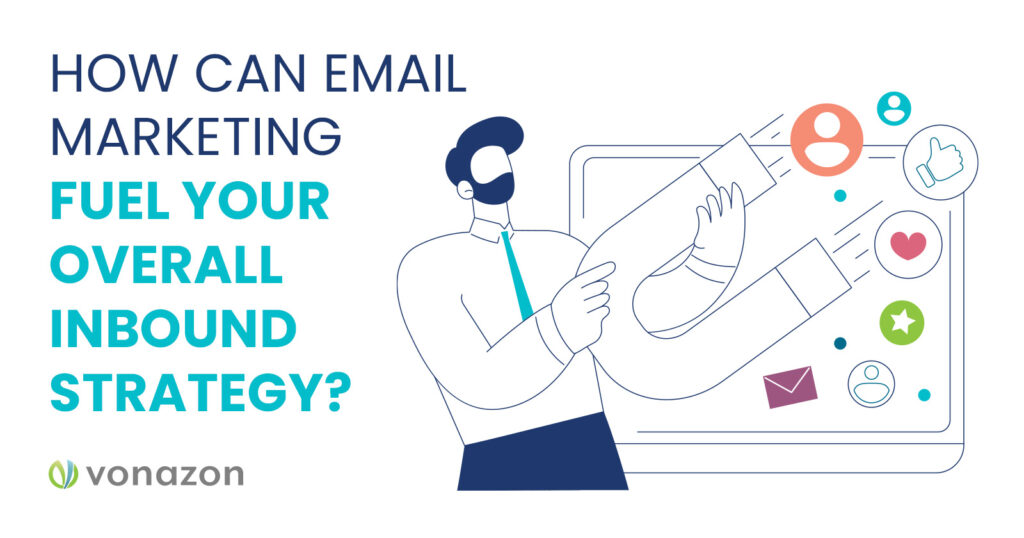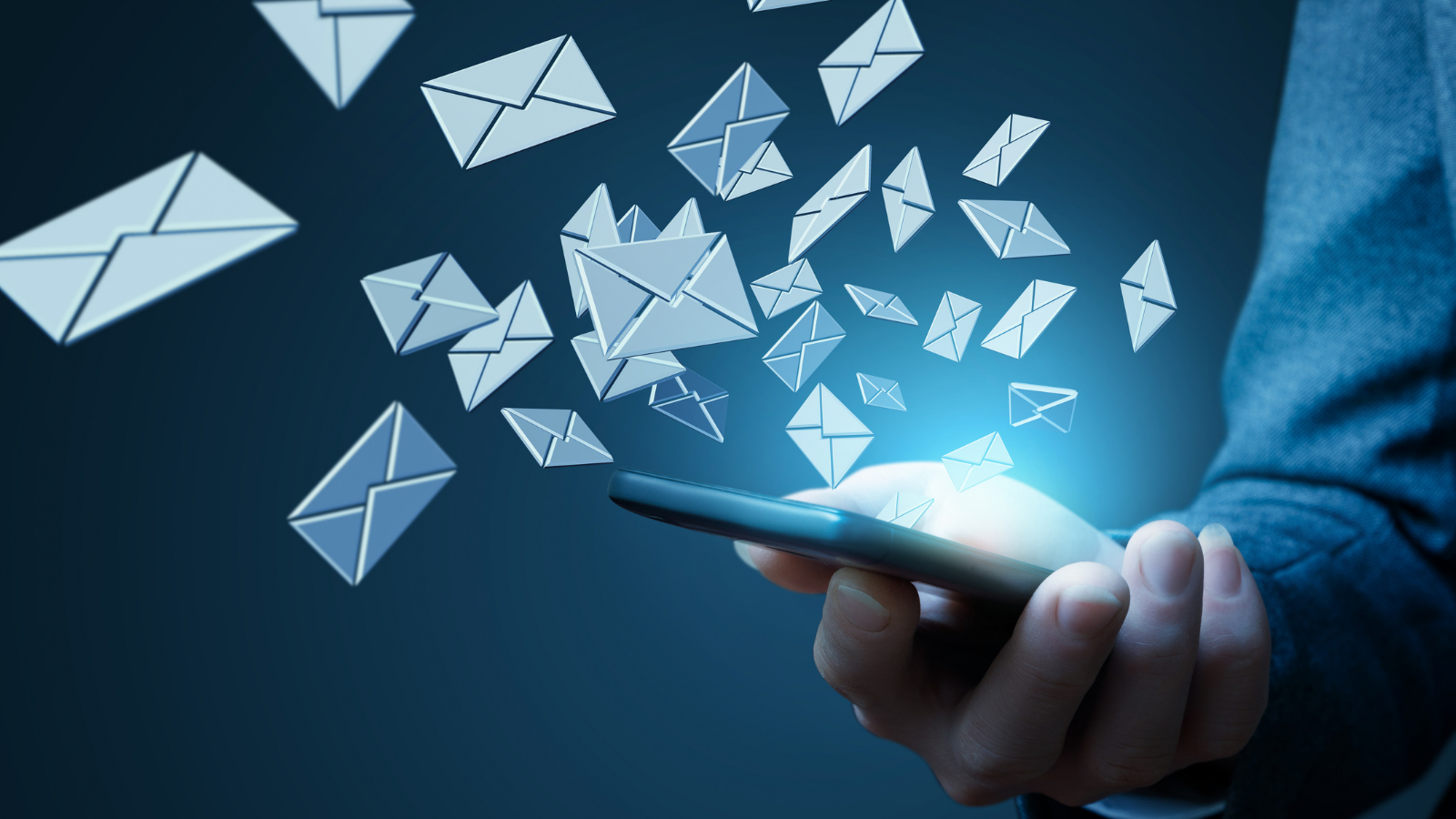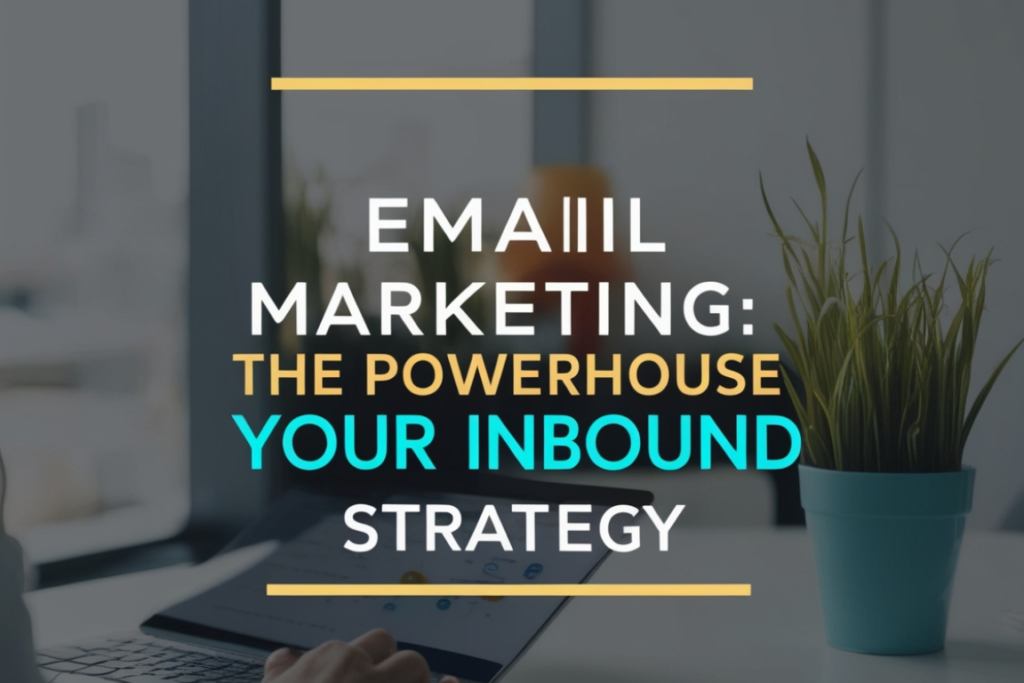Email marketing is essential for an effective inbound strategy. It nurtures leads, boosts engagement, and drives conversions.
Email marketing seamlessly integrates with your overall inbound strategy, providing a direct line of communication with your audience. It allows you to deliver personalized content, cultivate relationships, and nurture leads through the buying journey. With targeted email campaigns, you can segment your audience based on behavior and preferences, ensuring relevant messages reach the right people.
This not only increases engagement but also builds trust and loyalty. By consistently delivering value, you can guide prospects through the sales funnel and turn them into loyal customers. Effective email marketing enhances brand visibility, drives website traffic, and ultimately, fuels your inbound marketing efforts, leading to higher conversion rates and business growth.
The Role Of Email In Inbound Marketing
Email marketing is a powerful tool in the inbound marketing strategy. It helps businesses attract, engage, and delight customers. Understanding its role can fuel your overall inbound efforts.
Inbound Marketing Fundamentals
Inbound marketing focuses on attracting customers through relevant content. It pulls people toward your company and product. Instead of pushing your product onto them, you let them come to you.
There are four key stages in the inbound methodology:
- Attract: Draw in the right people with valuable content.
- Convert: Turn visitors into leads by gathering their contact information.
- Close: Transform leads into customers through nurturing.
- Delight: Keep your customers happy and turn them into promoters.
Email’s Unique Position In The Marketing Mix
Email marketing fits perfectly into the inbound strategy. It offers a personal touch that many other channels lack. Here are some unique benefits:
- Personalization: Emails can be tailored to each recipient’s needs.
- Cost-Effectiveness: Email marketing is budget-friendly, offering high ROI.
- Analytics: Track open rates, click-through rates, and conversions easily.
| Stage | Email’s Role |
|---|---|
| Attract | Send newsletters with valuable content. |
| Convert | Use lead magnets to collect emails. |
| Close | Send targeted offers to leads. |
| Delight | Share updates and special offers with customers. |
Email marketing is not just about selling products. It is about building relationships. It keeps your audience engaged and informed. This helps in nurturing leads and turning them into loyal customers. Using email effectively can transform your inbound marketing strategy.
Building A Solid Email List
Creating a solid email list is crucial for effective email marketing. A strong list helps you reach your target audience. It ensures your messages land in the right inboxes.
Effective Opt-in Strategies
Effective opt-in strategies are essential for building a quality email list. These strategies attract engaged subscribers who value your content.
- Use Sign-Up Forms: Place sign-up forms on your website. Make them visible and easy to complete.
- Offer Incentives: Give users a reason to subscribe. Offer discounts, free eBooks, or exclusive content.
- Leverage Social Media: Promote your email list on social media. Share the benefits of subscribing.
- Run Contests: Host contests that require an email sign-up. It’s a fun way to grow your list.

Maintaining List Hygiene and Quality
Maintaining list hygiene is vital for a high-performing email list. Clean lists have higher engagement and fewer bounces.
| Action | Description |
|---|---|
| Regularly Remove Inactive Subscribers | Identify and remove subscribers who haven’t engaged in months. |
| Use Double Opt-In | Confirm subscription with a follow-up email. Ensures genuine interest. |
| Monitor Email Deliverability | Track your deliverability rates. Adjust your list as needed. |
| Segment Your List | Group subscribers based on interests. Send more relevant content. |
Following these practices keeps your list healthy and engaged. Quality lists improve the success of your email campaigns.
Crafting Compelling Email Content
Email marketing remains a cornerstone of successful inbound strategies. Crafting compelling email content is crucial. It ensures your audience stays engaged and converts. Let’s dive into the core components of creating engaging emails.
Key Elements Of Engaging Emails
Engaging emails have several key elements:
- Clear Subject Line: The subject line needs to grab attention. It should be clear and concise.
- Personalized Greeting: Use the recipient’s name in the greeting. It makes the email feel personal.
- Compelling Body: The body should be relevant and valuable. Break it into short paragraphs or bullet points.
- Visuals: Use images or videos to enhance the message. Visuals make the email more appealing.
- Call to Action (CTA): Include a clear and direct CTA. Tell the reader what you want them to do next.
Personalization Techniques To Boost Open Rates
Personalization can significantly improve open rates. Here are some effective techniques:
- Dynamic Content: Tailor the email content based on user behavior. Dynamic content adapts to individual preferences.
- Segmentation: Segment your email list into smaller groups. Send targeted messages to each segment.
- Behavioral Triggers: Send emails based on specific actions. For example, send a welcome email when someone subscribes.
- Time Optimization: Send emails at times when recipients are most likely to open them. Analyze past data to find the best times.
These techniques make your emails more relevant. They increase the chances of your emails being opened and read.
Designing Emails For Conversion
Designing emails for conversion is a crucial part of any inbound strategy. The goal is to turn readers into customers. This requires careful planning and execution. Let’s dive into key areas to focus on.
Visual Design Considerations
The visual design of your email can make or break your campaign. A clean and appealing design grabs attention. Ensure your layout is easy to navigate.
- Use a clear and readable font.
- Include high-quality images relevant to your message.
- Maintain a consistent color scheme with your brand.
Keep paragraphs short. Use bullet points for readability. This makes your email more engaging.
Call-to-action Best Practices
The Call-to-Action (CTA) is the most important part of your email. It drives conversions. Your CTA should be clear and compelling.
| Best Practice | Example |
|---|---|
| Use Action-Oriented Words | “Shop Now” or “Learn More” |
| Make it Stand Out | Use a bright button |
| Position Strategically | Place above the fold |
Always include one primary CTA. Avoid cluttering with too many options. This keeps the focus clear.
Segmentation And Targeting
Email Marketing is a powerful tool for your inbound strategy. A key aspect of this is Segmentation and Targeting. These help ensure your messages reach the right audience at the right time.
Understanding Subscriber Segmentation
Segmentation involves dividing your email list into smaller groups. Each group shares common characteristics. This makes your emails more relevant to subscribers.
There are various ways to segment your list:
- Demographics: Age, gender, location
- Behavior: Purchase history, email opens
- Interests: Products viewed, topics clicked
Targeted Campaigns For Better Engagement
Targeted campaigns increase engagement. Personalized emails have higher open rates. They lead to more clicks and conversions.
Here are some examples of targeted campaigns:
| Campaign Type | Target Group | Goal |
|---|---|---|
| Welcome Series | New Subscribers | Introduce Brand |
| Re-engagement | Inactive Users | Revive Interest |
| Product Updates | Existing Customers | Inform About New Features |
Use segmentation and targeting to enhance your email marketing efforts. They make your messages more relevant and engaging. This boosts your overall inbound strategy.
Automation And Workflow Strategies
Automation and workflow strategies can transform your email marketing efforts. They help streamline communications, improve engagement, and drive conversions. Automation ensures that the right message reaches the right audience at the right time. Below, we explore key strategies to enhance your email marketing through automation.
Setting Up Effective Email Drip Campaigns
Email drip campaigns are a powerful automation tool. They send pre-written emails at specific intervals. This keeps your audience engaged over time. Here’s how to set up effective email drip campaigns:
- Define Your Goals: What do you want to achieve? Increased sales? More subscribers?
- Segment Your Audience: Group your audience based on behavior or interests.
- Create Valuable Content: Each email should provide value. Offer tips, insights, or special offers.
- Schedule Your Emails: Set intervals based on your audience’s needs. It could be daily, weekly, or monthly.
- Analyze and Adjust: Track open rates and click-through rates. Adjust your content as needed.

Credit: vonazon.com
Behavioral Trigger Emails To Increase Relevance
Behavioral trigger emails respond to specific actions your audience takes. These emails are highly relevant and timely. They can significantly boost engagement and conversions. Here are some common types of behavioral trigger emails:
| Trigger | Example Email |
|---|---|
| Sign-Up | Welcome email with a discount code |
| Abandoned Cart | Reminder email with product details and purchase link |
| Purchase | Thank you email with related product suggestions |
| Inactivity | Re-engagement email with special offers |
Implementing these strategies can improve your email marketing effectiveness. Use automation and workflow strategies to drive better results.
Measuring Email Marketing Success
Understanding the success of your email marketing campaigns is crucial. It helps you refine your strategies and achieve better results. Monitoring the right metrics and testing different elements can fuel your inbound strategy. For this contact us.
Key Performance Indicators (kips) To Monitor
Tracking the right KPIs can show how well your email campaigns are doing. Here are some essential KPIs to monitor:
- Open Rate: The percentage of recipients who open your email. A high open rate means your subject line is effective.
- Click-Through Rate (CTR): The percentage of recipients who click on links in your email. A good CTR indicates engaging content.
- Conversion Rate: The percentage of recipients who complete a desired action. This could be making a purchase or filling out a form.
- Bounce Rate: The percentage of emails that could not be delivered. High bounce rates can harm your sender reputation.
- Unsubscribe Rate: The percentage of recipients who opt-out. A high unsubscribe rate may signal that your content isn’t resonating.
A/b Testing And Continuous Improvement
A/B testing helps you find what works best for your audience. By comparing two versions of an email, you can identify which performs better. Here are steps to conduct effective A/B testing:
- Identify the Element to Test: Focus on one element at a time, such as subject lines, email design, or call-to-action buttons.
- Create Two Variations: Develop two versions of your email. Change only the element you are testing.
- Split Your Audience: Divide your email list into two groups. Send one version to each group.
- Analyze the Results: Compare the KPIs of both versions. Determine which variation performed better.
- Implement the Winning Version: Use the successful version in future campaigns. Continuously test to keep improving.
By monitoring these KPIs and using A/B testing, you can make informed decisions. This will help you improve your email marketing strategy and drive better results.
Avoiding Common Email Marketing Pitfalls
Email marketing is a powerful tool for any inbound strategy. But many marketers fall into common pitfalls. Avoiding these can fuel your overall efforts. Below, we dive into key areas to watch. This will help you avoid common email marketing errors.
Navigating Email Deliverability Challenges
One major hurdle is ensuring your emails reach the inbox. Emails often end up in the spam folder. Here are ways to boost deliverability:
- Authenticate Your Emails: Use SPF, DKIM, and DMARC protocols.
- Maintain a Clean List: Remove inactive subscribers regularly.
- Monitor Sender Reputation: Keep an eye on your sender score.
- Avoid Spam Triggers: Use clear and professional language.
Using these methods can increase your email reach. This will help drive better results from your campaigns.
Staying Compliant With Email Regulations
Compliance is crucial in email marketing. Ignoring regulations can lead to penalties. Here are key points to ensure compliance:
| Regulation | Key Requirements |
|---|---|
| CAN-SPAM Act | Include a clear unsubscribe link. Use accurate subject lines. |
| GDPR | Obtain explicit consent. Provide data access and deletion options. |
| CASL | Get express consent. Offer a clear opt-out mechanism. |
Following these guidelines keeps your email marketing legal. It also builds trust with your audience.
Integrating Email With Other Inbound Tactics
Integrating email marketing with other inbound tactics can supercharge your strategy. Emails can complement content marketing, social media, and other channels. This creates a cohesive and powerful approach to attract, engage, and delight your audience.
Synergy With Content Marketing And Social Media
Email marketing and content marketing are a perfect match. You can share blog posts, ebooks, and whitepapers via email. This drives traffic to your website and engages your audience.
Social media integration amplifies your reach. Share your email content on platforms like Facebook, Twitter, and LinkedIn. Encourage your followers to subscribe to your email list. This boosts both channels and creates a seamless experience for your audience.
- Share Blog Posts: Include recent blog links in your emails.
- Promote Ebooks: Offer downloadable content through email.
- Social Sharing: Use social buttons in your emails.
- User Engagement: Encourage social followers to join your list.
Email’s Role In Multichannel Campaigns
Email plays a crucial role in multichannel campaigns. It serves as a bridge, connecting various channels and providing a unified message. For instance, use email to follow up on social media interactions or to nurture leads generated from PPC ads.
Emails can also provide personalized content based on user behavior across channels. This ensures a consistent and relevant experience, boosting engagement and conversion rates.
- Consistent Messaging: Align email content with other channels.
- Lead Nurturing: Follow up on leads from different sources.
- Personalization: Tailor emails based on user behavior.
| Channel | Integration Method | Benefits |
|---|---|---|
| Content Marketing | Share valuable content via email | Increased website traffic and engagement |
| Social Media | Promote email content on social platforms | Expanded reach and follower growth |
| PPC Ads | Follow up leads through email | Higher conversion rates |
Future Trends In Email Marketing
Email marketing is evolving fast. New trends are shaping its future. Staying ahead is crucial for success. This section covers key trends that will fuel your inbound strategy.
Emerging Technologies Shaping Email
Technology in email marketing is advancing quickly. Artificial Intelligence (AI) is a game-changer. AI helps in personalizing emails. It analyzes data to create targeted content.
Machine Learning (ML) is another emerging tech. ML predicts customer behaviors. It helps in sending the right message at the right time.
Interactive Emails are gaining popularity. They offer dynamic content. Users can interact without leaving the email.
AMP (Accelerated Mobile Pages) for email is another trend. AMP makes emails faster and more engaging. It enhances the user experience significantly.

Credit: leadg2.thecenterforsalesstrategy.com
Adapting Strategies for Tomorrow’s Audience
Audiences are changing. Strategies must evolve to keep up. Segmentation is vital. Divide your audience into smaller groups. Send relevant content to each segment.
Personalization is key. Customized emails resonate more with recipients. Use recipient names, preferences, and past behaviors.
Automation streamlines your efforts. Automated emails save time. They ensure timely communication with your audience.
Mobile Optimization is crucial. More people read emails on mobile devices. Ensure your emails look great on all screens.
| Trend | Impact |
|---|---|
| Artificial Intelligence | Personalized content |
| Machine Learning | Behavior prediction |
| Interactive Emails | Enhanced engagement |
| AMP for Email | Faster, engaging content |
Frequently Asked Questions
What Is Email Marketing in Inbound Strategy?
Email marketing is a method of sending targeted messages to engage, nurture, and convert leads within your inbound strategy. It helps in building relationships with potential and existing customers by providing valuable content and personalized communication.
How Does Email Marketing Drive Inbound Success?
Email marketing drives inbound success by nurturing leads with personalized content, boosting engagement, and guiding prospects through the sales funnel. It enhances brand loyalty and increases conversion rates by delivering relevant information directly to the audience’s inbox.
Why Integrate Email Marketing With Inbound Strategy?
Integrating email marketing with your inbound strategy ensures cohesive communication, enhances lead nurturing, and improves conversion rates. It allows for targeted, personalized messaging that aligns with your overall marketing goals, driving better results and a stronger customer relationship.
What Are Key Benefits Of Email Marketing?
Key benefits of email marketing include increased engagement, higher conversion rates, cost-effectiveness, and improved customer retention. It provides measurable results and allows for precise targeting, ensuring your message reaches the right audience at the right time.
Conclusion
Email marketing is a vital part of your inbound strategy. It engages, nurtures, and converts leads effectively. Integrate it seamlessly for optimal results. Track performance and adjust tactics to stay ahead. By leveraging email marketing, you can drive growth and strengthen your overall marketing efforts.
Invest in it and watch your business thrive.

